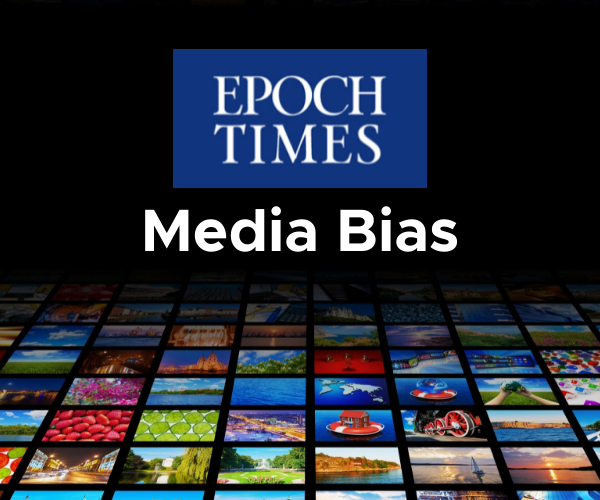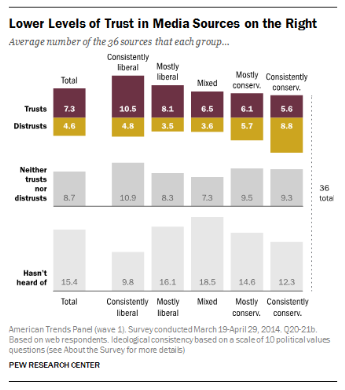
The Epoch Times was founded in 2000 in New York, New York by John Tang and others in affiliation with the Falun Gong new religious movement. The Epoch Times is a multi-language newspaper and media company that publishes primarily in English and Chinese. While most wouldn’t consider The Epoch Times to be a part of the mainstream media, it has risen in popularity within right-wing circles and is the 7th most followed account on the social media platform Gab. With overall trust in media seen as more conservative, and some calling into question The Epoch Time’s ability to balance facts with politics it begs the question. Is The Epoch Times a reliable source of factual reporting, or simply a political mouthpiece?

Source: Pew Research
Does Reliability Matter?
Reliability refers to how factually accurate, or credible, a fact, or source, is. In this case, we’re taking a closer look at the overall reliability of The Epoch Times as an entity and publisher. Reliability is important because a more reliable source is more truthful that can be trusted to give an accurate depiction of events without purposefully inserting or emitting facts to try and shape an audience’s perspective.
So how do we measure a media company’s reliability?
We take a multitude of factors into account when trying to measure reliability, examining multiple articles for larger trends within the media source. Unreliability within articles often presents itself through less objective and more opinionated language that tends to place a greater focus on the author’s opinions than the facts of the story. Red flags for reliability include:
- Presence of subjective/opinionated language within articles
- Lack of cited sources, or use of sources with low degrees of credibility
- Unfounded claims that go beyond simply reporting on an issue
Aside from keeping an eye out for less factual reporting within articles, there are several positive indicators of reliability to keep an eye out for. Green flags for reliability include:
- Absence of subjective/opinionated language in articles
- Credible sources cited (e.g., neutral sources, .gov, .edu websites)
- Facts and statistics backed by multiple relevant outside sources
- Use of primary sources when possible (e.g., interviews, quotes)
- Information that remains consistent when researched with reputable sources
When trying to assess an article’s bias, one important measure we consider is an article’s accuracy, or whether an article is able to report factually on the claims they make. Two important factors to keep in mind when trying to determine how accurate an article is, are the article’s levels of selection bias and omission bias.
Selection bias occurs when stories and facts are selected or deselected, often on ideological grounds, to create a narrative that supports a particular news publisher’s political leanings. This can include things like only reporting on issues important to that particular political side, or only reporting on facts that support a certain political interpretation of a story. Omission bias, on the other hand, refers to when different opinions and political views regarding a situation are purposefully left out so that the reader is only exposed to the ideological perspective supported by the author. This can include things like only publishing quotes from those who support the political message or the article, or failing to include the reasoning given by those opposed to an action supported by the article.
It’s important to keep in mind these two types of biases when trying to assess an article’s level of accuracy, as authors making use of them often sacrifice reliability in doing so. Now let’s examine how bias can influence accuracy by looking at a few Epoch Times articles rated by Biasly.
How Does The Epoch Times Fare in its Biasly Reliability Score?
We made use of Biasly’s political bias indicator to assess how reliable The Epoch Times is overall. At Biasly, accuracy is rated on a percentage scale ranging from 0-100. Our analysts gave The Epoch Times an accuracy score of 89 percent, making it reliable overall. This puts it above several competitors including Fox News, with an accuracy score of 82 percent, and ABC News, with an accuracy score of 78 percent. But what do these scores mean in practice?
While we went over many of the red flags suggesting a less reliable news article, what truly marks the differences between an article that is reliable and one that isn’t? Well, that brings us back to one of the most common complaints media companies receive alongside accusations of unreliability, that of political bias. Political bias can, in addition to skewing the way articles are framed, influence the internal reliability of an article or an article’s accuracy, but how exactly does this occur?
Accuracy and Reliability in The Epoch Times
If you check out The Epoch Times’ page on the Biasly website, you can see the reliability and accuracy ratings given on some of their most recent articles. While there is some variance in reliability from article to article, the majority tend to trend closer to our average. You’ll also notice that changes in reliability are often associated with changes in bias, often due to the presence of selection and omission bias, meaning articles rated as being more politically biased tend to score lower in terms of reliability, and less biased articles score higher. Here Biasly uses a percentage rating scale spanning from -100 to 100 with more negative scores indicating more liberal biases, and more positive scores, more conservative biases.
These differences are present due to the way bias can influence some of the indicators of reliability listed above. More biased articles make use of emotional and subjective language to argue an opinion, while more factual articles provide more objective accounts of events.
Let’s look at an article titled “‘Road to Socialism’: South Carolina Governor Says Businesses Are Failing Because Staff Earn More in Unemployment.” This article was given an analyst bias score of 31 percent (conservative) and an author bias score of 43 percent (conservative). The reliability score of this article is close to the average for The Epoch Times at 83 percent, giving it a significant deal of reliability.
Let’s take a look at the way claims are presented in this article by examining the following passage:
“Last week, the Department of Labor reported that only 266,000 jobs were created in April, falling far short of economists’ and analysts’ expectations, while Republican elected officials have said it is, in part, due to the extra $300 weekly benefits that were included in pandemic relief bills that were signed into law last year.
Here the article lays out the situation to the reader, reporting that fewer jobs are being created than predicted. The article then moves on to state that Republicans believe this is a problem caused by unemployment benefits. The use of objective facts, like numbers reported by the Department of Labor, gives the article a greater degree of reliability. Additionally, by clearly stating that it is the opinion of Republican officials, and not the author, that benefits are the cause of the issue, the article is able to further cement its objectivity.
Now let’s look at another passage created to showcase opposing views on the issue:
Some Democrats and progressive advocacy groups have claimed the jobless aid doesn’t play a role in why some businesses aren’t finding employees.
“There are lots of anecdotal reports swirling around about employers who can’t find workers,” Heidi Shierholz, policy director at the left-wing Economic Policy Institute, wrote in a recent opinion article. “But a closer look reveals there may be a lot less to this than meets the eye.”
Here, this article demonstrates how factual reporting can avoid accuracy issues created by selection and omission bias. Here the article provides arguments made by Democrats, who claim unemployment benefits have nothing to do with the issue businesses are facing, choosing not to omit arguments that are seemingly in opposition to the article’s central theme. The article then goes further by quoting a notable figure, selecting a credible source from the opposing side, and ensuring reporting on opinions held by both sides is objective and equitable.
Overall, this article, while biased in the sense that negative sentiments toward Democrat politicians can be found, is able to retain a high degree of reliability by focusing on the reporting of credible facts, and through the inclusion of arguments and facts that favor both sides of the issue. It is these measures that help this article stand out from less reliable articles that use the selection of favorable facts and the omission of unfavorable facts to craft a story that supports a specific opinion, even at the loss of overall reliability.
Analysis of The Epoch Times Opinion Articles
While bias in the form of selection and omission can be more or less present depending on the article in question, there is one type of journalism where bias on the part of the author is universal; the opinion piece. Whereas typical reporting focuses on the facts of any particular event, the opinion piece is published to convey the author’s personal view on a topic. These pieces are subjective and made to persuade an audience of a particular point of view, making them less accurate and reliable as a whole.
In order to demonstrate this, let’s break down a recent opinion piece published by The Epoch Times titled “America Needs a Transfusion”. It doesn’t take long for the author to state their argument, that many of America’s institutions need to be overhauled. Let’s look at the following quote:
“American schools do the opposite. Diminishing the importance of the Founding Fathers, infusing students with critical race theory, American schools send children home confused and even ambivalent about their country.”
Here the author makes it clear they believe that American schools are inferior to those in other countries. They accuse schools of “diminishing” the Founding Fathers and “infusing” students with ideology. The use of these more inflammatory word choices leads to the formation of negative sentiments toward the things being described. Most notable here, however, is that no evidence is provided to support these claims. No evidence is provided to prove that anything is being diminished or that students are being infused, and no evidence is provided to suggest that would be harmful.
The same elements are present in another passage, this time criticizing Medicare:
“Here’s one example. Before Medicare, the price of health insurance was the price of auto insurance (or property insurance or life insurance), about $200 a month ($50 a month for a young person) in 2023 dollars—what it would again be if the government was completely removed from the market for health care.”
Instead of reporting on facts, and then providing credible evidence or quotes to support them, this opinion piece focuses first and foremost on conveying the author’s point of view. Here the author openly takes a side politically, something reflected in Biasly’s rating of 54 percent (very conservative). The author supports the points they make using subjective language, like those regarding the price of health insurance. The author does this while omitting opposing views and supporting facts to validate their claims more clearly.
So is The Epoch Times Reliable?
To put it simply: it depends.
While we were able to give The Epoch Times as a whole a high-reliability score, reliability can vary greatly between articles. Factors like well-supported claims and an author’s use of selection and omission bias within any given article can create significant differences in reliability even between articles from the same publisher. Additionally, the nature of an article, like whether or not it’s an opinion piece, can alter its overall reliability.
While some articles do a great job managing their objectivity and neutrality by providing credible and factual reporting, others fall short of the bar. This highlights the importance of learning to identify the red and green flags of reliability and of making use of an indicator like Biasly’s News Check chrome extension to analyze the bias and reliability scores of any given article. You’ll find that as you continue to see how different articles are rated, you can gain a clearer understanding of how to spot markers of reliability and accuracy issues within an article, allowing you to improve your own media literacy.
Disclaimer: Pew Research Center bears no responsibility for the analyses or interpretations of the data presented here. The opinions expressed herein, including any implications for policy, are those of the author and not of Pew Research Center.


























